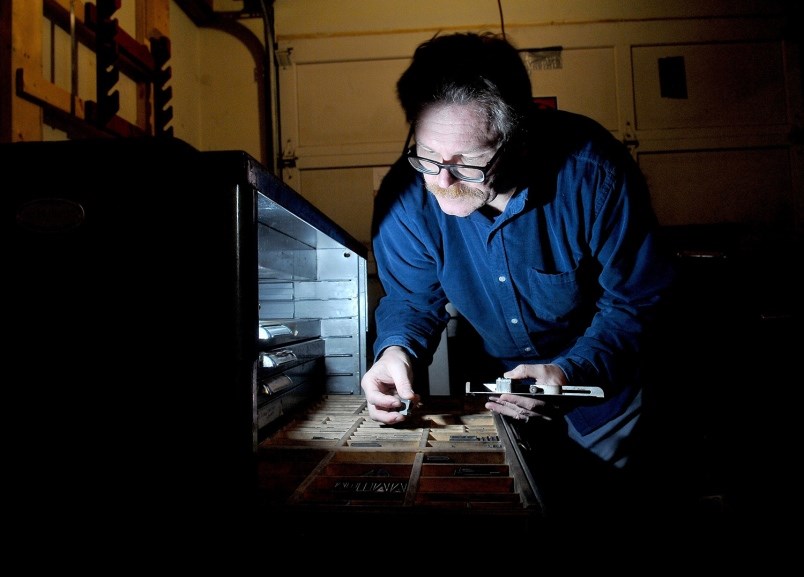The late Jim Rimmer may have been one of New Westminster’s most famous residents. But he didn’t hit a baseball or win the Stanley Cup.
Rimmer was renowned for his typography.
From his stained-glass-lit studio behind his home on Ninth Street, Rimmer created fonts that set a standard for typographers around the world. He then cast each letter and character into lead blocks that he could use in his collection of ancient typesetting machines and letter presses to print one-sheets, posters and books that were coveted by collectors.
Rimmer also designed logos that became part of our everyday visual landscape: the flowing script for the band, Heart; Simon Fraser University; a linocut of a cabin in the woods on tins of Murchie’s tea.
When Rimmer passed away on Jan. 8, 2010, he was mourned in the graphic arts and typography world as “a jazz musician with inky fingers.”
I met Rimmer in 2004.
He’d just won some sort of international award which seemed worthy of recognition in the local paper, so I was dispatched with a reporter for an interview and photo shoot.
Walking into his orderly studio was like entering Willy Wonka’s chocolate factory, but for typography. The walls were adorned with framed examples of his work, posters he’d designed, broadsides of poems, pages from books. Neatly arranged cabinets contained drawers of the various fonts he’d cast to assemble in the heavy, old typesetter that sat at an angle by a massive, arched stained glass window that bathed the room in a warm, orange glow.
His basement workshop that adjoined the studio was cluttered with all manner of ancient, heavy iron linotype and monotype machines, and letterpresses he’d acquired from print shops that had moved on in technology.
This was the roots of the very pages of the print edition of this newspaper, the technology to commit those words to ink and paper pretty much unchanged since Johannes Gutenberg invented the printing press in the 15th century. It was like spending an afternoon when newspapering was a noble and honourable profession, and assembling the day’s newspaper was the toil of craftsmen in dark, noisy press rooms stationed at heavy, clattering cast iron machines.
When I learned Rimmer’s 1914 Colt Armoury (yes, the same company that manufactures guns) letterpress had found a new home and purpose with a graphic artist in Port Moody, I had to reconnect.
Markus Fahrner said he couldn’t believe the good fortune of his find.
While much of Rimmer’s printed works, printers’ dummies, manuscripts and type design work was acquired by the Simon Fraser University library after his passing, the fate of his collection of heavy machinery was less certain.
Fahrner said it’s important to keep the old machines running rather than have them end up as decorative curios in restaurants or antique shops.
“I really admire the craft,” Fahrner said. “I love the way it forces you to slow down.”
In fact, a poster that might take Fahrner a couple of hours to design on a computer can take days to assemble and print on the letterpress.
“It’s slow and precise,” he said.”You suddenly have so much to know about the process, like the way the ambient temperature of the room affects the ink, the type of paper you’re using, how heavy an impression you want to make on the paper.”
The end product, Fahrner said, has a depth and life that can’t be produced digitally.
“There’s an intrinsic love and energy in the things you produce,” he said.




